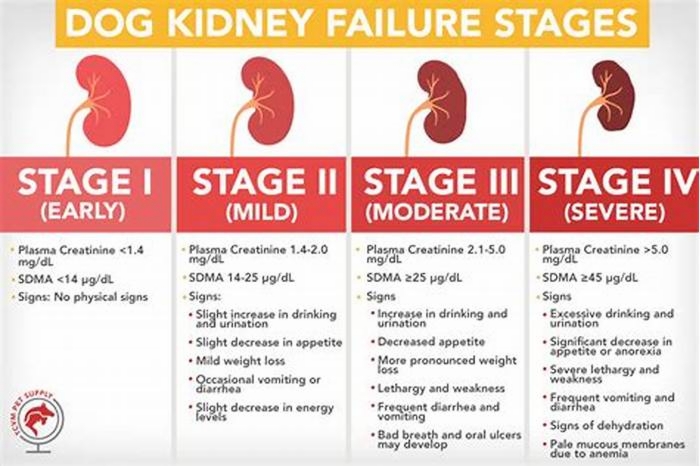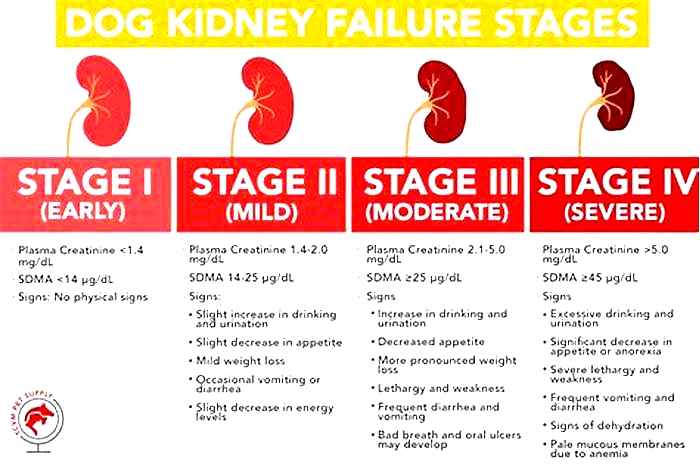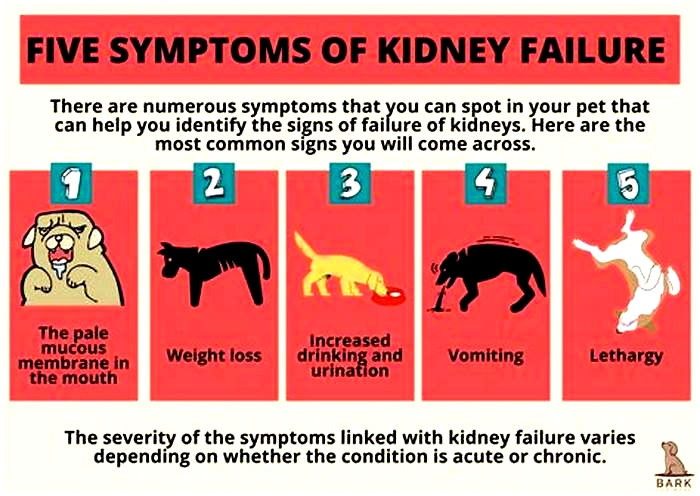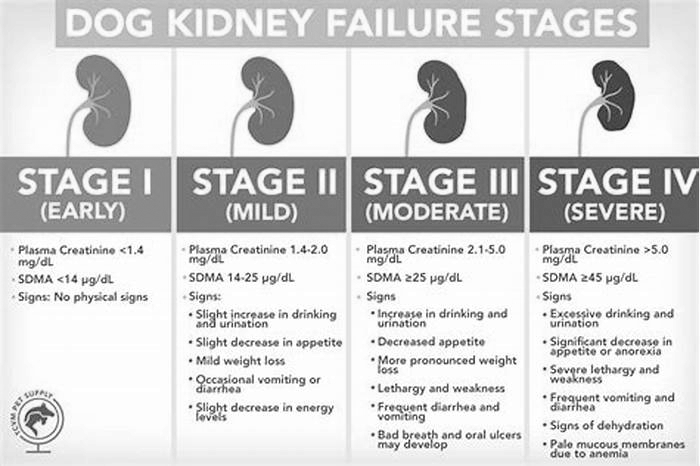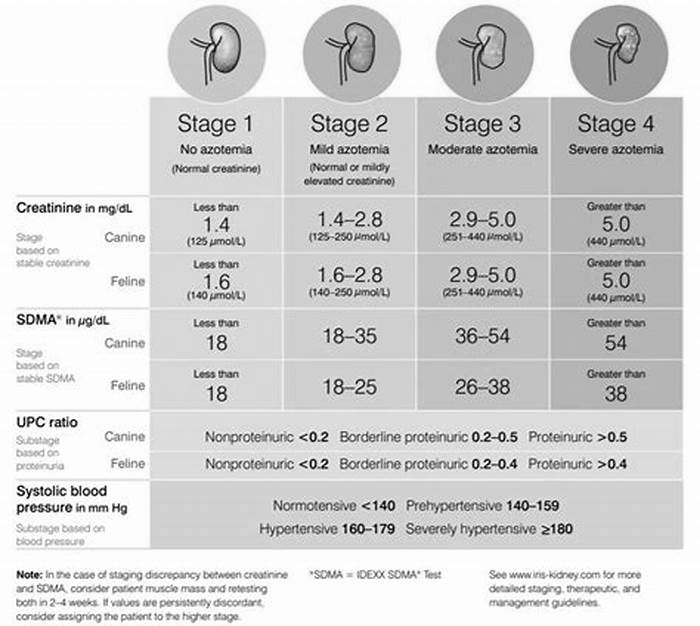kidney failure dogs stage 4

Chronic Renal Failure (CRF) in Dogs
What Is Chronic Renal Failure in Dogs?
Chronic renal failure (CRF), renal insufficiency, and chronic kidney disease (CKD) are all medical terms used to describe the same condition. It occurs when the kidneys are unable to perform their required tasks at the same level of efficiency as before.
Dogs have two kidneys located on either side of their abdomen, that play a vital role in filtering waste from the body. Additionally, the kidneys serve to regulate fluid, mineral, and electrolyte balance; conserve water and protein; and play an important role in maintaining blood pressure and red blood cell production by making a hormone called erythropoietin.
Dogs cannot survive without their kidneys, and unfortunately, kidney transplants are yet to be a viable solution. Dialysis (a treatment for failing kidneys including the removal of waste) is often expensive and is extremely rare in dogs. However, early diagnosis and intervention is key to help maintain your dogs quality of life.
Once diagnosed, CRF is then classified into four different stages based on severity of clinical signs and laboratory values:
Stage I: Clinical signs usually not apparent
Stage II: Some clinical signs noted
Stage III: Many clinical signs noted, and pets often feel sick
Stage IV: Majority of clinical signs noted, pets often present as a crisis
Causes of Chronic Renal Failure in Dogs
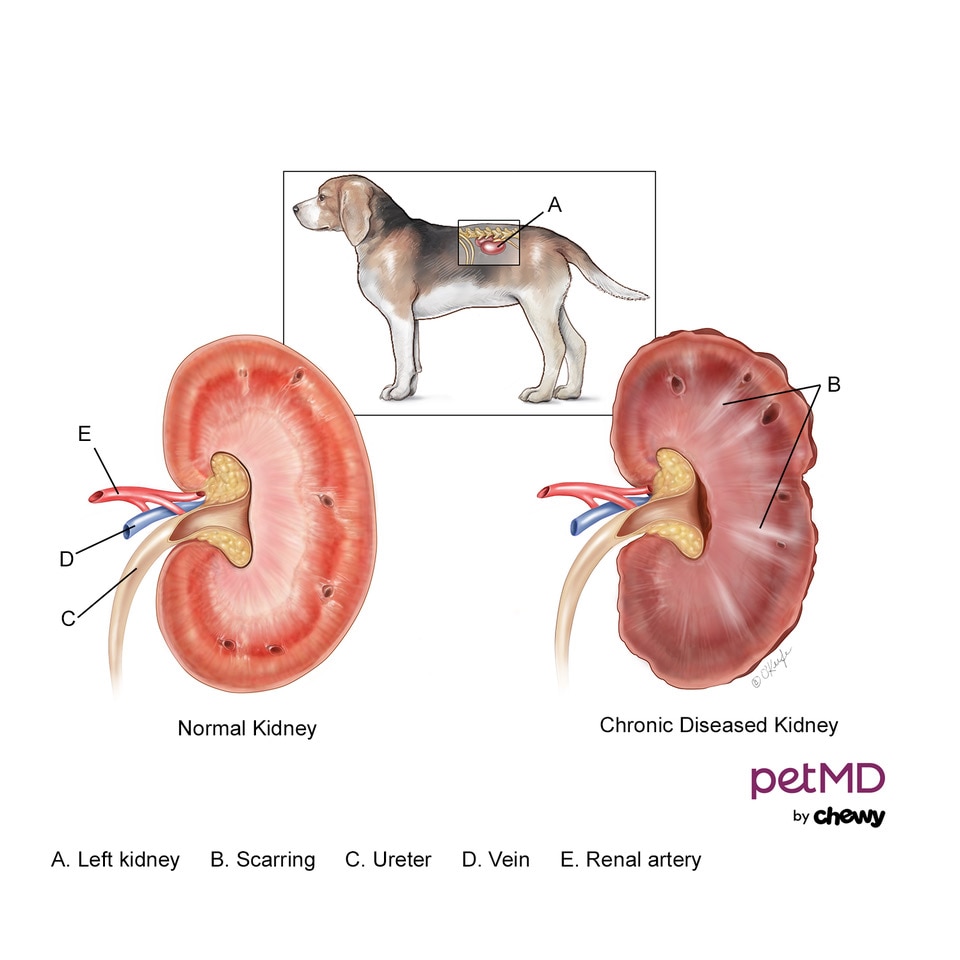
The term chronic in chronic renal failure means that the process has been ongoing, is progressive, and unfortunately, cannot be reversed. For some dogs, the disease could have occurred after a serious kidney injury such as from a severe infection (i.e., leptospirosis, pyelonephritis) or ingestion of a toxic substance such as anti-freeze, grapes, or raisins, and certain antibiotics.
For others, it could be inherited, such as with glomerular disease (a specific type of renal kidney disease) and amyloidosis (a rare organ disease) as seen in breeds like the Bernese Mountain Dog and Shar-pei.
For others, it could be attributed to underlying immune-mediated diseases, stroke-like events, or even from clotting disorders. In cases for newly diagnosed dogs the underlying cause will likely remain unknown.
Symptoms of Chronic Renal Failure in Dogs
Clinical signs are often related to the severity of the CRF stage, meaning there are additional and more severe signs noted with stages III and IV than there are with stages I and II. Dogs often exhibit symptoms including:
Foul breath
Weight loss
Decreased appetite
Some dogs may show muscle wasting and signs attributed to high blood pressure, such as vision loss and weakness.
How Veterinarians Diagnose Chronic Renal Failure in Dogs
CRF is often diagnosed based on routine blood work and a urinalysis looking specifically at kidney markers such as:
Blood urea nitrogen (BUN): A by-product of protein metabolism, higher values can often indicate kidney failure
Creatinine (CREA): Measures how well kidneys are filtering waste from blood
Phosphorous: Elevated phosphorus levels typically indicate kidney damage
Electrolytes (Sodium, potassium, chloride)
Calcium
Red blood cell count: A low red blood cell count may indicate kidney failure
Symmetric dimethylarginine (SDMA): An additional test to help determine if kidney disease is present; it can be used for early detection of kidney disease
Urine specific gravity: A marker of how diluted or concentrated the urine is. Usually the higher the number, the more concentrated the urine is and the greater ability of the kidney to conserve water.
Your veterinarian will most likely recommend additional diagnostic testing, including:
A urine protein to creatinine (UPC) ratio to quantify how much protein is being lost in the urine
A urine culture, as dogs in CKD are more likely to acquire urinary tract infections
A blood pressure evaluation
Radiographs or abdominal ultrasound to screen for kidney stones or infarcts (areas of dead tissue)
Treatment of Chronic Renal Failure in Dogs
Dogs with CRF are generally older and have other ongoing issues, such as arthritis or liver disease, and so the management of CRF can be challenging. However, CRF can be managed, mostly with the aid of medications, diet, and hydration.
Specific management is geared toward each stage of the disease, with each progressive stage recommendations built upon the previous stage recommendations. Any dog in any stage with an increase in either UPC (urine protein to creatinine ratio) or high blood pressure will most likely be treated with medication.
Throughout your dogs life, any disease process or illness that could affect his hydration should be treated promptly with IV fluids. Other drugs will be prescribed based on the dogs diagnosis since renal metabolism will be affected and can lead to overdosages and/or worsening of the kidney disease.
Additionally, for all stages, fresh water should always be available, drinking should be encouraged, and adequate nutrition should be given daily. Dogs diagnosed with CRF are most likely prescribed a kidney friendly diet, which may include feeding your dog a canned diet of wet food that contains additional water.
Recovery and Prevention of Chronic Renal Failure in Dogs
As chronic renal failure is not curable and often progressive (although the timeline is variable) in nature, dogs diagnosed early on will benefit from nutritional management and consistent veterinary attention, which may include more frequent check-ups and blood work.
Dogs in stages I and II may often be monitored for further progression of signs, and some may be given a prescription diet specifically geared to help the kidney, by limiting the amount of work they must do.
Many dogs can go on to have a decent quality of life for many months to years. Dogs in stages III and IV often require more medical and dietary assistance. If secondary anemia is present, erythropoietin injections can be given at the direction of your veterinarian.
Dietary supplements, and phosphorus binders (to treat high phosphorus levels) may also be given for low potassium. Anti-nausea and anti-emetic (anti-vomiting) medications can also be prescribed for dogs with a poor appetite, vomiting, or nausea. Fluids given either intravenously or underneath the skin can help dehydration. Because of the severity of signs often seen in dogs with stage III and IV, and the amount of care and effort required to support these dogs, some may be humanely euthanized.
Chronic Renal Failure (CRF) In Dogs FAQs
How long can a dog live with kidney failure without treatment?
Left untreated, dogs in kidney failure will die, usually within a few days to a few weeks. Death is often preceded by loss of appetite, dehydration, weight loss, vomiting, and multi-organ failure.
Can dogs recover from chronic renal failure?
There is no cure for CRF. However, if CRF is caught early and managed correctly, most dogs that experience kidney disease can go on to live a relatively normal life with some changes and long-term management.
Can chronic renal failure in dogs be reversed?
While CRF is not reversible, early treatment can provide your pet with a happier, longer, and fuller life. Regular, semi-annual checkups are key to early diagnosis and treatment of the development of chronic renal disease.
Featured Image: iStock.com/Korneeva_Kristina
WRITTEN BY
Michael Kearley, DVMVeterinarian
Dr. Michael Kearley graduated from the University of Florida College of Veterinary Medicine in 2013. He graduated with a certificate in...
Kidney Disease in Dogs: Signs, Symptoms, and Treatment
Your dogs kidneys are essential organs that filter waste products from the bloodstream. When the kidneys are weakened, either by acute or chronic kidney disease, your dogs health could suffer. Because kidney disease progresses over time, its important to learn the common symptoms so tha you can recognize them. If you catch kidney disease in dogs early on, treatment can slow down the progression and allow your dog to live longer.
What Is Kidney Disease in Dogs?
Kidney disease in dogs is sometimes called renal or kidney insufficiency because it occurs when a dogs kidneys stop doing their job as efficiently as they should. The main job of the kidneys is to help clear and excrete waste products from the blood and convert them to urine, says Dr. Jerry Klein, Chief Veterinary Officer for the AKC. If the kidneys are not working properly, these waste products can build up in the blood, causing detrimental effects.
Dogs can get either acute kidney disease, which develops suddenly, or chronic kidney disease (CKD), which develops slowly and worsens over an extended period. Both involve loss of kidney function, but they result from different circumstances. Acute kidney disease is a sudden attack or injury to the kidney, whereas chronic kidney disease is a slow, degenerative loss of kidney function, Dr. Klein explains.
What Causes Kidney Disease in Dogs?
Dr. Klein warns that kidney disease could be caused by a lot of things, including infection (such as with the bacteria that causes leptospirosis), trauma, genetics, drugs, toxins, cancer, mechanical obstructions (like kidney stones), and degenerative diseases (where the job and form of the affected body part get worse over time). Anything that decreases blood flow to the kidneys, such as dehydration or heatstroke, can cause the kidneys to fail.
Acute kidney disease in dogs can be caused by exposure to hazardous materials, including toxic plants such as lilies, certain drugs, harmful foods such as grapes or raisins, or antifreeze. Puppy-proofing your home and yard can keep your dog away from potentially harmful items or foods that could be toxic.
Chronic kidney disease in dogs is also associated with growing older. Because kidney tissue cant regenerate once its damaged, the kidneys can wear out over time. As small-breed dogs often live longer than large-breed dogs, they tend to show early signs of kidney disease at an older age10 years old or more, compared to as young as 7 for the large breeds.
What Are the Symptoms of Kidney Disease in Dogs?
The earliest signs of kidney disease in dogs are increased urination and therefore increased thirst. Other symptoms dont usually become apparent until about two-thirds of the kidney tissue is destroyed. So, in the case of CKD, the damage may have begun months or even years before the owner notices. Because of this, its common for the signs of kidney disease in dogs to seem like they came out of the blue when in fact, the kidneys have been struggling for a long time.
Other signs of chronic kidney disease in dogs to watch for include:
Dr. Klein says there are some rarer symptoms of kidney disease in dogs to be aware of, as well. On occasion, there can be abdominal painurinary obstructions or stonesand in certain instances, one can see ulcers in the oral or gastric cavity. In extreme cases, little or no urine is produced at all.
What Are the Stages of Chronic Kidney Disease in Dogs?
Kidney disease in dogs is measured in stages. Many veterinarians use the IRIS scale, which has four stages. Blood work measurements like creatinine and SDMA (biomarkers for kidney function) allow your vet to assign your dog to a particular stage which will determine the exact treatment.
Dr. Klein explains, The stages determine how well the kidneys can filter waste and extra fluid from the blood. As the stages go up, the kidney function worsens. In the early stages of CKD, the kidneys are still able to filter out waste from the blood. In the latter stages, the kidneys must work harder to filter the blood and in late stages may stop working altogether.
How Is Kidney Disease in Dogs Treated?
Dialysis (a medical procedure that removes waste products and extra fluid from the blood) is far more common in humans than in dogs, although peritoneal (kidney) dialysis can be performed in some cases. On rare occasions, surgical kidney transplant is possible in dogs.
But Dr. Klein specifies that depending on the type and stage of kidney disease, the main treatments for CKD are diet changes and administration of fluids, either directly into the veins (intravenous) or under the skin (subcutaneous). The balancing and correction of electrolytes are extremely important in the management of kidney patients, he explains.
Proper nutrition is needed, and there are many available diets formulated for cats and dogs with kidney issues, some by prescription only. Your veterinarian can help guide you to the most appropriate diet for your pet.
Because kidney disease, particularly in the late stages, can cause a dog to lose their appetite, it can be difficult to encourage your dog to eat enough. Dr. Klein advises, There are medications used as appetite stimulators available, such as the prescription drug mirtazapine. Capromorelin has recently been FDA-approved for dogs to address appetite in chronic kidney disease.
When Do You Need to Call Your Vet?
The prognosis and expected life span for a dog with kidney disease depend on the type of disease, the speed of progression, and underlying conditions present in the dog. However, the more serious the disease, the poorer the outcome. Thats why its so crucial to catch the illness early on.
According to Dr. Klein, In chronic kidney disease, there are methods, such as diets and medications, that can be used to lessen the burden of work the kidneys need to do and may help slow down the progression from one stage to the next. In acute kidney disease, there is less time and fewer choices available to prevent further damage to the kidneys and to try to jump-start the kidneys to get them to function normally.
Regular veterinary exams, including bloodwork, are an excellent way to spot kidney problems before the outward symptoms become apparent. And if you notice any of the above signs, dont hesitate to get your dog to the vet for further testing. It can make a huge difference in preserving kidney function and your dogs well-being for as long as possible.

